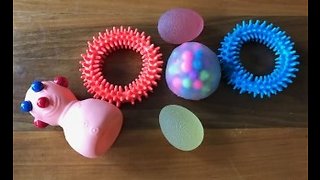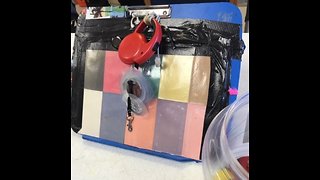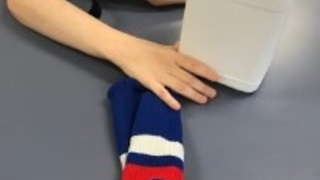Premium Only Content

Brush Stringing for Sensory Processing Disorders
Many people including myself enjoy the feeling of rubbing a brush against the arms and hands. I received training decades ago on how to administer the Wilbarger Protocol that involves rubbing with a surgical brush every 2 hours to decrease tactile defensiveness. I find the hair brush purchased from the Dollar Store much more calming. The hair brush provides a greater amount of stimulation. I can barely feel the surgical brush when I rub it on my arms. I tied one of these hairbrushes to a client’s table so that he can decide when to rub it on his arms and hands and how much pressure to use to meet his sensory needs. This hairbrush also feels good when squeezed!
The video demonstrates the same stringing activity used by 2 clients with very different abilities. The blind client has very good motor planning skills and is able to push the fabric pieces with slits onto the brush to slide down the cord. When I first started working with him 5 years ago, he refused to touch most objects. He is so tactile defensive that he refuses to eat! (he has a GI tube). Now he enjoys pushing golf balls through a small opening so it takes force to make it go down. This has helped him tolerate deep pressure to his palms and tolerate touch in general. Notice how flat his hands are because he has avoided grasping inside his palms all of his life!
The second client has motor planning challenges. He loves to fidget with objects to meet his sensory needs, including this hair brush. He wasn’t eager to slide rings down the cord but realized that he was able to fidget with the hair brush as he pleased while working on this task. I only offer large plastic rings to string because he does not have the motor planning skills to manipulate the fabric squares with slits that you see the first client using. I really love how I am able to individualize activities for my clients to meet their sensory and motor needs….
This activity may be adapted using different types of sensory items such as a Koosh ball or motorized tooth brush tied to the end of the cord. Explore using cord of shorter or longer lengths, larger or smaller rings according to the individual’s abilities to help them achieve easy success and gradually add challenge.
Learn more about activity adaptations on my website and blog:
http://www.RecyclingOT.com
http://www.RecyclingOT.blogspot.com
http://www.FromFlappingtoFunction.com
-
 1:49
1:49
RecyclingOT
6 years agoPrevocational Skills and Sensory Processing Disorders
163 -
 1:08
1:08
RecyclingOT
6 years agoClothespins Bowl Activity for Sensory Processing Disorders
635 -
 9:25
9:25
RecyclingOT
6 years agoFidget Tools for Sensory Processing and Anxiety Disorders
6.99K1 -
 1:49
1:49
RecyclingOT
7 years agoAdapting Velcro Activity for Sensory Processing Disorders
542 -
 1:15
1:15
RecyclingOT
7 years agoFabric Ring Stack for Children with Sensory Processing Disorders
68 -
 1:16
1:16
RecyclingOT
6 years agoDog Leash Sensory Stringing for Developmental Disabilities
49 -
 1:15
1:15
RecyclingOT
7 years agoStringing Sensory Shapes for Individuals with Autism
7.48K -
 1:35
1:35
RecyclingOT
6 years agoSensory Lamp Ring Stack for People with Autism Spectrum Disorders
729 -
 1:46
1:46
RecyclingOT
7 years agoDeep Pressure Sensory Processing Activity: Pulling Rings off Cord Inside Sock
542 -
 1:48
1:48
WTMJMilwaukee
6 years agoOpposition to Animal Processing Facility
12